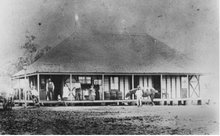Waiting for a meeting to start one morning last week, I was flicking idly through a book on social determinants of health (hey there weren’t any Vogues or Readers Digests lying around and I am a geek). My eye was caught by a chapter on food and health. It wasn’t about the usual “eat proper food and you’ll be okay” although it did discuss appropriate eating. What it was about was the politics of food and food production. The single thing that leapt out at me was that as far as health researchers can tell, humans need to eat on a weekly basis 20 to 30 biologically distinct kinds of food. The chapter went on to discuss why we don’t and in many cases, aren’t able to do this.
Quite often I hear nostalgia for the way things were “back then” when we all ate healthy food and worked the land. When you think about it though, being able to consume a wide range of foods is a pretty recent phenomena. Without refrigeration, transport and modern agriculture, diets could be very limited and lives were concomitantly short and in some cases, painful. Earlier this year I read the The 100 Mile Diet and was impressed at the authors’ dedication to eating locally. They did however, find it very difficult in winter when the selection of fruit and vegetables available in a 100 mile radius was extremely limited. For many weeks they lived on potatoes, cabbage and carrots. Not only were they bored, but apparently it would have affected their health (although their moral superiority would remain impeccable.)
I have family members with experiences of very limited choice in food. One lived on onions and bread even when she was pregnant. The child of that pregnancy is shorter than siblings born in later years when food was cheap and varied. Another relative lives in a part of the world where there are no green vegetables available in winter. They eat vegetables preserved in summer and anything that they can sprout inside their house. These things do have marked effects on their health.
So although I am greatly in sympathy with many of current concerns about what and how food is grown, processed and distributed, I also think that people sometimes tend to forget how difficult everyday living was even a handful of decades ago here and how little food many people around the world have. After all, it is the well-fed who have the luxury of being concerned with such things as carbon footprints, food miles, organic, biodynamic, free-range etc. We are the ones who can worry about eating for health rather than simply to stay alive.
Here in Southeast Queensland we are incredibly lucky with the range and quality of food available to us. Even if I bound myself to a 100 mile diet, I would still be able to eat mangoes, peaches, cherries, pineapples, apples, pears, seafood, grains of all kinds, exotic and less exotic vegetables of many kinds, meat, dairy products…the list goes on. For many migrants to this area it must have seemed like some kind of paradise. My mother-in-law remembers being astonished by all the food and fruit available when she arrived in Brisbane and learning for the first time that you could put on weight simply eating fruit.
And now instead of going off to till the fields or search for my dinner, I can sit down to count my food groups and types. I wonder, do broccoli and cauliflower count as biologically distinct given that they can cross-pollinate?
Thursday, 12 March 2009
Eating ideas
Labels:
100 Mile Diet,
agriculture,
everyday life,
food,
health,
history,
migrants,
plants,
Queensland
Subscribe to:
Post Comments (Atom)

No comments:
Post a Comment